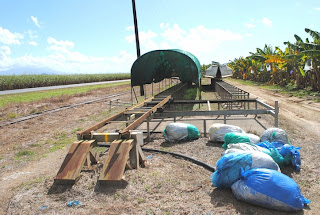With the start of the season having commenced, a further trip "up north" provided some opportunity to view a few cane trains in action.
Mulgrave Mill was having a maintenenance shift on the morning I arrived so there was an opportunity to view the unloading station engineered by the late Harvey Flanders.
 |
| Cane comes in on the right hand side line to be tipped and then is taken to the empty line on the left by a traverser. The two modified bins are for the spilt cane billets that are cleared away. |
In 2012 Mulgrave Mill is crushing all cane from Babinda northwards and has obtained some additional locomotives out of those previously stationed at Babinda and South Johnstone. The state of the former Babinda Mill track from Babinda to McDonnell Creek will not allow for the use of bogie locomotives on this run as yet.
 |
| South Johnstone Mill number 22 has become Mulgrave Mill's 26 MERINGA. |
 |
| South Johnstone Mill's number 20 has become Mulgrave's 25 CUCANIA. This was formerly Moreton Mill's MORETON, seen here waiting for cane at Bundy Loop, McDonnell Creek. |
The local banana industry has picked up some ideas of 2ft gauge railroading. Here is an example of a commonly used technology locally. There is a shaded full line on the left and an empty line on the right, connected by a traverser. Four-wheel rail vehicles are rolled off onto a rubber tyred vehicle upon which the picked fruit is placed. On return to this holding siding, the fruit-laden rail vehicles are placed in the shaded section awaiting pick up by the road vehicle that will take them to the packing plant. This way the bananas are potected from bruising and sunburn.
 |
| Banana siding. The rails are just flat steel bars. |
With the inclusion of the Mulgrave Mill tramway in the South Johnstone system, the main line from the former Mourilyan area crosses the QR North Coast Line at Ramleh. Here Clyde number 18 comes through the catchpoints with a loaded rake.
 |
| This locomotive was formerly Mourilyan Mill number 2. |
Sugar boxes were once used to convey raw sugar to Mourilyan Harbour but have not been seeen in the district for a while. However, these two examples from the Herbert River district were spotted outside the Bradken engineering works at Boogan.
 |
| These Sucrogen bulk sugar boxes are sitting on the old Mourilyan Mill line outside what was once Camuglia's engineering works. |
Heading further south, South Johnstone Mill's number 38 was found alongside Utchee Creek Road. This locomotive is based south of the large 'Silver Bridge' over the South Johnstone River which locomotives are now no longer allowed to cross, so when it rachers the bridge it pushes its load ahead of it to be picked up by another locomotive on the mill side.
One of the old 'canetainer' wagons that was used in association with long-distance road transport at South Johnstone Mill was noted in use at Formosa Road. Most of these vehicles are stored out of service at the Goondi Mill site.
Not much time left in the day by the time Tully was reached. Here is rebuilt 3ft 6in gauge TULLY-9 with plenty of glass in the rear cab wall, heading north with empties.

















